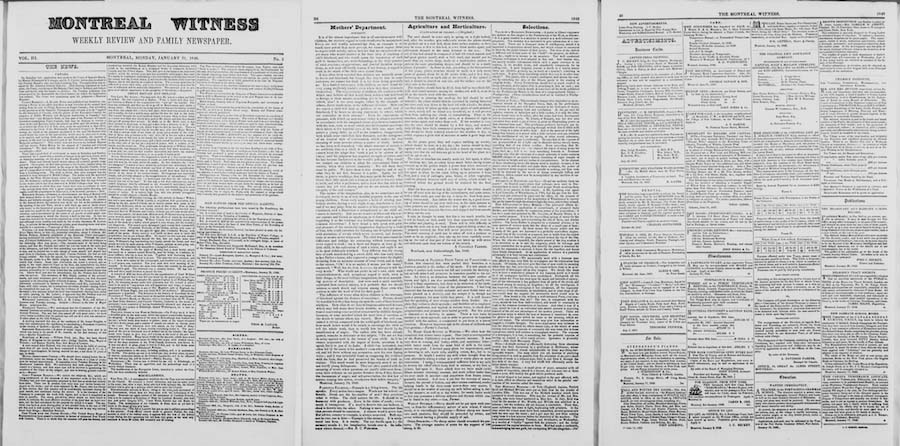| title | canonical_url | image | description | excerpt | card_src | card_alt | banner_src | banner_alt | author | publish_on | |||||||
|---|---|---|---|---|---|---|---|---|---|---|---|---|---|---|---|---|---|
Centuries of newspapers are now easily searchable thanks to HTCSS |
|
BAnQ's digital collections team recently used HTCSS to tackle their largest computational endeavor yet –– completing text recognition on all newspapers in their digital archives. |
BAnQ's digital collections team recently used HTCSS to tackle their largest computational endeavor yet –– completing text recognition on all newspapers in their digital archives. |
Newspaper spread |
Newspaper spread |
Josephine Watkins |
|
The Bibliothèque et Archives nationales du Québec (BAnQ) has been using the HTCondor Software Suite (HTCSS) to help digitize their vast collections of documents since 2013. Just this year, they built a powerful computing cluster out of staff workstations, using HTCSS’s cycle scavenging capabilities to tackle their largest computational endeavor yet.
Anything published in Québec –– books, magazines, newspapers, and more –– is all housed within BAnQ, an institution uniting Québec’s National Library, the province’s National Archives, and Montreal’s vast public library. “You can imagine the result is a colossal amount of materials,” attests Senior Computer Technician David Lamarche, “ranging from the discovery of the Americas and the very beginning of the colony, to whatever’s being written in newspapers this week.” Ultimately, these archives and collections reflect important historical moments, rich cultural heritage, and a tremendous amount of data.
To tackle this archival mountain, the digital collections team at BAnQ enlists the help of the HTCondor Software Suite (HTCSS) to transform images of pages into text, which can be analyzed in-house and made available to the public. This was the goal of their largest computational project yet –– completing text recognition on decades of articles from 114 archived newspapers in order to make them available for full-text search. This feat took them several years, but on July 12 of this year, the digital collections team finished text recognition on the very last newspaper.
Now, with full-text search available, users of the BAnQ Digital Archives and Collections have nearly 260 years of cultural and historical moments at their fingertips. Information that used to be buried in the ink of these newspapers, accessible only through time-consuming searches and tedious record-keeping, can now be unearthed with mere strokes of a keyboard. This saves users immense amounts of time and elevates the cultural value of the documents themselves.
The end result wouldn’t have happened quite as fast without the ability of HTCSS to automate the work across BAnQ’s staff workstations. File analyses, conversions, and text recognitions that typically took weeks or even months to complete are now completed in the same week, or perhaps even overnight.
“HTCondor has become nothing less than a central pillar of our team,” attests David Lamarche, the HTCondor administrator for the digital collections team. “We want to give credit to HTCondor for its role in this project's success, as we would not have reached that milestone quite so quickly without it!”
But accelerating digitization was only half the battle. David reflects that the project’s main challenge “was not only to process this backlog of 114 newspapers, but to do so while minimizing the impact on our daily workflows for newly-digitized titles.” Continuing, he explains two HTCondor features that were vital to the project’s completion: “The first is HTCondor's scalability, which allowed us to easily add more workstations to our resource pool. The second is HTCondor's resource distribution mechanisms, which we were able to configure to control how many resources could be allocated to processing older titles.”
Over the course of the project, the team used HTCSS to process over 5 million files. Many of the newspapers span decades, and some centuries, with new issues published monthly, weekly, or even daily. For every issue, each page is manually scanned before the team uses HTCondor to analyze the file, convert it into a high-quality version, prepare it for text recognition, conduct text recognition, and finally convert the file into a smaller, lower-quality version that can be disseminated on a web platform. Throughout the workflow, the team integrated a variety of software tools into their jobs, which ran by cycle scavenging on 50 workstations when they were not being used by in-office staff.
Cover of La Patrie newspaper. July 8, 1921The La Patrie newspaper, which circulated as one of the main news sources in Québec from 1879 to 1978, was one of the larger publications that the team digitized. Recounting of the Great Depression, both world wars, and a plethora of other important historical events are buried in its –– now digital –– ink. Consisting of more than 600,000 files, text recognition on La Patrie would take an estimate of 18 years on a single workstation. With HTCondor, this publication was successfully processed in merely 8 months.
Digitization –– enabled by the HTCondor Software Suite –– offers a solution to the tradeoff between the preservation of these cultural documents and their accessibility, and even adds value back into the documents themselves by enabling full-text searches. In the future, BAnQ’s digitization team hopes to expand their use of HTCSS to text recognition on handwritten documents and perhaps even object recognition in photographs.
...
Browse the newspapers in BAnQ’s digital collections.

